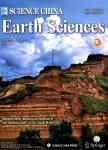Spatiotemporal evolution of C3/C4 vegetation and its controlling factors in southern China since the last glacial maximum
Spatiotemporal evolution of C3/C4 vegetation and its controlling factors in southern China since the last glacial maximum作者机构:Institute of Geology and GeophysicsChinese Academy of SciencesBeijing100029China Key Laboratory of Cenozoic Geology and EnvironmentInstitute of Geology and GeophysicsChinese Academy of SciencesBeijing100029China Guanzhou Institute of GeochemistryChinese Academy of SciencesBeijing510640China
出 版 物:《Science China Earth Sciences》 (中国科学(地球科学英文版))
年 卷 期:2019年第62卷第8期
页 面:1256-1268页
核心收录:
学科分类:070903[理学-古生物学与地层学(含:古人类学)] 0709[理学-地质学] 07[理学] 0708[理学-地球物理学] 0704[理学-天文学]
基 金:supported by the “Strategic Priority Research Program” of the Chinese Academy of Sciences (Grant No. XDA05120103) the National Natural Science Foundation of China (Grant Nos. 41603013 & 41572163)
主 题:Stable carbon isotope Long-chain n-alkanes C3/C4vegetation Last Glacial Maximum Holocene Climate Optimum period
摘 要:To date, few research have been reported on the evolution of C3/C4 vegetation in southern China, and the main mechanism influencing the evolution of C3/C4 vegetation is unclear. That makes it difficult for researchers to understand the competition mechanism of C3 and C4 plants under different climate environments and its relationship with the climate factors. It is also not conducive for researchers to assess the influence of future climate change on regional C3/C4 vegetation. Exactly, C3/C4 vegetation change in the regional-scale will have a significant impact on the global carbon cycle and agricultural production.Therefore, it is especially important to reconstruct the evolutionary history of C3/C4 vegetation in southern China and clarify the influencing mechanism of climate change. In this study, we systematically analyzed stable carbon isotope(δ13 C) of the longchain n-alkanes in sediment samples from eight lakes and four peat profiles in southern China, to reconstruct the spatiotemporal evolution of C3/C4 vegetation in these regions since the Last Glacial Maximum(LGM) and to investigate the climate factors that affect the C4 plant abundance change in the research area. The integrated long-chain n-alkane(C27–C33) stable carbon isotope results of samples from Zhanjiang Huguangyan Maar Lake, Xingyun Lake, Lugu Lake and Dingnan peat showed that, from the LGM to the Early Holocene, C4 plant relative abundance exhibited a gradually increasing trend from 21% to 34%. In the Middle Holocene, the C4 plant abundance significantly declined and reached a lowest value of 10%. In space, the C4 plant abundance generally exhibited a gradually declining trend from south to north in the LGM and the Early Holocene, while it showed an opposite trend in the Holocene Climate Optimum(6.0 cal ka BP). It reflected that the main influencing factor on C4 plants spatial distribution was changing from temperature to precipitation. This study indicated that temperature was the dominant factor affecting C4 plant distribution in southern China, however, when the temperature condition was appropriate, an increase in precipitation(especially more spring precipitation) would reduce the competitive advantages of C4 plants. Therefore, the combination of temperature and seasonal precipitation was the important factor that determines the C3/C4 vegetation proportion change in the southern China. Under the premise that the temperature will rise and precipitation will increase in the future, the reduction of a competitive advantage for the C4 plants could affect agricultural production in China.



